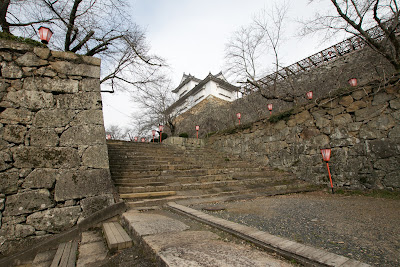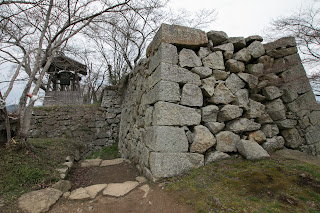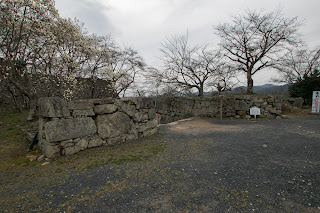Tsuyama Castle
-Huge stone fortress located in inland area-
Name: Tsuyama castle (Tsuyama-jo)
Alias: Kakuzan jo (Crane hill castle)
Place: Yamashita Tsuyama city, Okayama
Type: Hill castle
Built: Originally 15th century, expanded in 17th century
Remaining remnants: Stone walls, moats and gate (moved)
Title: 100 famous Japanese castles, Designated national historical site
Brief History
Tsuyama castle (津山城) is located at Tsuruyama hill, in the center of Tsuyama basin at Tsuyama basin. Tsuyama area places at the center of east half of Chugoku region, and an important connecting point of roads from Himeji city (Hyogo prefecture), Okayama city (Okayama prefecture). Tottori city and Yonago city (Tottori prefecture). Later Tsuyama area prospered as a posting town of Izumo kaido road, and also river transportation of Yoshiigawa river.
In medieval era, the center of Mimasaka province (north part of Okayama prefecture) where Tsuyama belongs located at Innosho area, an area about 10 kilometer west from central Tsuyama area. There was a residence of the governor, and also Kamae castle located near Yoshiigawa river. Originally Tsuyama area was governed by Yamana clan, but after weakening of Yamana clan, this area became the target of struggle by surrounding strong warlords such as Amago clan, Ukita clan or Mouri clan. Finally under Toyotomi government Ukita clan held Tsuyama area by 1600.
But as a result of the battle of Sekigahara, Ukita clan was confiscated its territory and expelled, then Hideaki Kobayakawa (1577-1602) became the lord of Mimasaka province along with Bizen province and Bicchu province. But Hideaki died in youth without successor in 1602, and Kobayakawa clan was extinguished then.
Disturbant history of Mori clan
Current Tsuyama castle was built by Tadamasa Mori (1570-1634), next lord of Mimasaka province. The history of Mori clan as feudal load stem from Yoshinari Mori (1523-1570). Yoshinari was originally a retainer of Toki clan, a house of governor of Mino province (Gifu prefecture) before 1552. After the fall of Toki clan, he went to Owari province (western Aichi prefecture) and changed his master to Nobunaga Oda (1534-1582), a warlord of Owari province.
During Nobunaga’s campaign to reach to Kyoto in 1568, Yoshinari actively worked and was appointed as a commander of Kaneyama Castle. But in 1569, Nobunaga confronted current Muromachi shogunate Yoshiaki Ashikaga and was encircled by surrounding enemies. Nobunaga's main troops were attacked by Ishiyama Honganji army at Osaka, and at the same time an ally of Asakura clan, a house of guard of Echizen country (Fukui prefecture), Asai clan, a lord of north Omi country and monk soldiers of Hieizan temple trooped to Kyoto.
At that time Yoshinari protected Usayama castle (Shiga prefecture), which was located at lake shore of Lake Biwako (Shiga prefecture) and guarded the road to Kyoto. Attacked by overwhelming soldiers Yoshinari was defeated and died, but remaining castle guarders kept Usayama castle and stopped their troop to Kyoto.
To reward for Yoshinari’s loyalty, Nobunaga treated favor of Mori family. His living eldest son, Nagayoshi Mori (1558-1584) was appointed to a commander of Kaneyama castle located on Mino province (Gifu prefecture) and attached to Nobutada Oda (1557-1582), a eldest sonof Nobunaga. In addition to this, his younger brothers Shigetoshi (famous as Ranmaru, 1565-1582), Bomaru and Rikimaru served as pages to Nobunaga. Tadamasa was youngest son and still child, thus he stayed in Kaneyama castle. Nagayoshi was a brave and rushing general, tremendously fought during invasion to Takeda clan at 1582 and was given north part of Shinano province (Nagano prefecture).
But Mori family was hit by continuous tragedy from then. In 1582, at the time of the incident of Honnoji, a coup d'etat to Nobunaga by his regional commander Mitsuhide Akechi (1528-1582), Shigetoshi, Bomaru and Rikimaru all died with Nobunaga and Nobutada. Among brothers only Nagayoshi who stayed Shinano province and Tadamasa survived.
In addition to this, in 1584, a conflict occurred between Hideyoshi Toyotomi (1537-1598), former general of Nobunaga, and Ieyasu Tokugawa (1542-1616), former ally of Nobunaga, aiming at next hegemony. Nagayoshi supported Hideyoshi along with his father in law Tsuneoki Ikeda (1536-1584), and to alter the fixed situation he attempted to make a surprise attack to Mikawa province (eastern part of Aichi prefecture), former base of Tokugawa clan directly.
But it took too much time to capture Iwasaki castle (Aichi prefecture) on the way to Mikawa procince and this secret attack was found by Tokugawa army. Whole Tokugawa army assaulted this surprise attack troop from backside at Komaki-Nagakute, and Nagayoshi was defeated and died there along with Tsuneoki Ikeda. Only Tadamasa was remained, succeeded Mori clan in youth and served for Hideyoshi.
Movement to Tsuyama and built of castle
After the Hideyoshi’s death in 1598 there was a battle of Sekigahara between Ieyasu Tokugawa and Toyotomi supporting group in 1600, and Tadamasa belonged to Tokugawa side. After the battle Tadamasa was once transferred to Kaizu castle (current Matsushiro castle) at north part of Shinano province, but in 1604 along with the death of former lord Hideaki Kobayakawa (1577-1602), Tadamasa was appointed as a lord of Mimasaka province (north part of Okayama prefecture) with larger territory by Ieyasu.
Af first Tadamasa stayed at Kamae castle, but Kamae castle located at narrow plain area and not suitable for both of defense and commerce. From 1604 Tadamasa started to build a new castle at Tsuyama. It was a large castle and took time for construction, and the castle was finally completed in 1616.
Structure of Tsuyama castle
Tsuyama castle locates at Tsuruyama hill, which is about 30 meter high and places near the merging point of Miyakawa river and Yoshiigawa river. Tsuruyama hill is a rectangular shaped hill of 500 meter length and 300 meter width, and Tsuyama castle spreads whole part of this hill. Being protected its east side by Miyakawa river, terraces spread north, west and south side of the hill.
This castle mainly consist of three layer of terraces. The central area is a reverse L shaped area at highest point, and a five story and one basement floor main tower of steeple style (nearly straight shape tower without decorative roof) stood on the basement at western edge of the area. Main gate into central area located at southeast edge of the area, and backside gates from northward were placed at the north edge of the area, being guarded by subtower.
Secondary area surrounds from north, west to south part of central area, and main route from third area was at the middle of its south line. Third area also encircled from north, west to south part of secondary area, and main gate also existed at the middle of south line. As south half of each area has plenty space, main route into central area from southward consists of wide path and large magnificent stone steps, but also securely protected by combined gates and winding paths. On the other hand, backside route from northward is narrow path with steep steps.
Tsuyama castle had many buildings compared with its size. Other than main tower, there were 31 turrets and 15 gates in central area, 12 turrets and 7 gates in secondary area, 17 turrets and 11 gates in the third area and 17 turrets in outer area. Combination of layers of terraces guarded by tall stone walls and many buildings on them might be quite magnificent.
Afterward of Tsuyama castle
Mori clan was transferred from Tsuyama at 1698 due to lack of successor, and Matsudaira clan, which stem from Hideyasu Yuki (1574-1607), second son of Ieyasu and commander of Fukui castle (Fukui prefecture), served as a governor of Tsuyama area until the end of Edo era.
The buildings of castle were well remained throughout Edo era, but subsequent to Meiji revolution all building except one gate moved to neighbor shrine were demolished and the site of the castle is used as a park. In 2005, Bicchu turret which located on the front side of central area, was reconstructed. Even without building, the dignity and beauty of stone wall is one of the best among Japanese castles and worth for visiting.
Access
20 minutes walk from JR West Kishin-sen line Tsuyama station. 20 minutes drive from Chugoku-Jidoshado Expressway Tsuyama interchange or Innosho interchange.
Related Castles
Kaneyama castle -Rowdy young lord of Sengoku era-
Fukui Castle -Magnificent stone walls remain in city center-

























































































































































































































































































































































































No comments:
Post a Comment